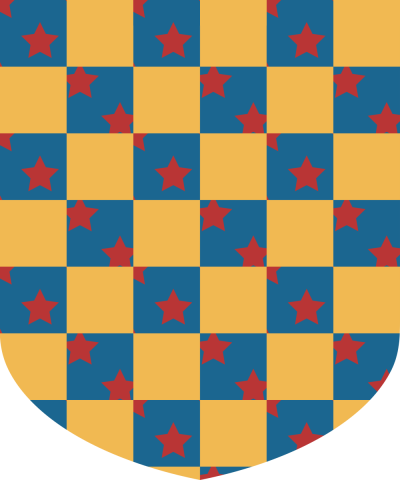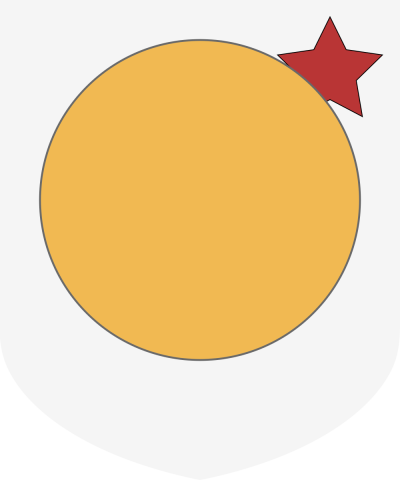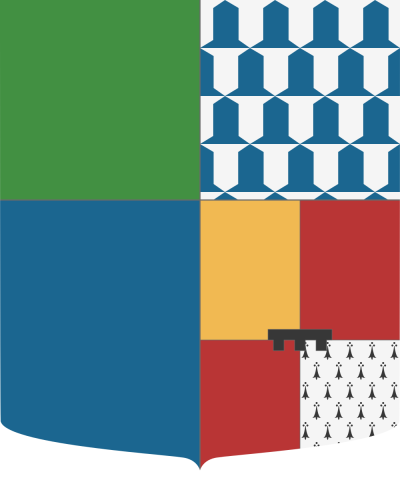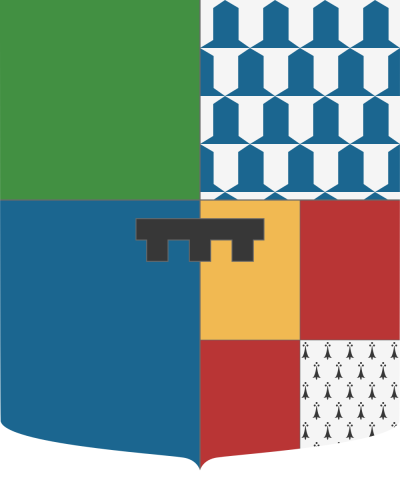A correspondent has suggested that it might be useful to explain how DrawShield uses semi-colons. That's a good point, and it would also be good to explain other punctuation characters too. So here goes...
Punctuation to remove ambiguity
The Comma
A list of tinctures can be ambiguous, especially if it involves treatments, since we can give treatments two ways, for example:
checky azure and or
azure checky or
Both these produce a pattern of blue and gold squares.
Given the above, what does this mean?
Checky azure mulletty gules and or
Lets see what DrawShield does:-

It has made the assumption that "azure mulletty gules" is a single treatment. What if we didn't mean that? This is where the comma comes in, note the subtle difference below:
Checky azure, mulletty gules and or
And the difference this produces in DrawShield:

The comma is also useful to separate longer lists of tinctures and generally makes things more readable, for example:
Tierced in pale azure checky or, vert honeycombed gules, argent masoned sable
The Semi-Colon
The semi-colon provides a similar way to separate charges in list of charges with positions. Consider:
argent a mullet gules in sinister chief a roundel or
What should be "in sinister chief"? The mullet or the roundel? Let's see what DrawShield defaults to:
 What if we actually wanted the roundel to be in chief? Well we could rearrange the blazon, but that doesn't help if we have a longer list of charges - we need to resolve the ambiguity with a semi-colon:
What if we actually wanted the roundel to be in chief? Well we could rearrange the blazon, but that doesn't help if we have a longer list of charges - we need to resolve the ambiguity with a semi-colon:
argent a mullet gules; in sinister chief a roundel or
Which produces what we want:

In general, you can assume that the semi-colon means "I have finished describing this charge and I am moving on to something else".
The Double Semi-Colon
What! There's no such punctuation mark... There is in DrawShield! Consider the following quartered blazon:
quarterly
1) vert
2) vair
3) azure
4) quarterly
i) or
ii) and iii) gules
iv) ermine
overall a label sable
Where does the label go? Does it go on the ermine (i.e. the most recently mentioned shield). Does it go over the final quartering (4) or does it go over the whole shield? There is no obvious way to tell what is meant. Let's see what DrawShield does:
 Okay, that seems sensible, it has associated the "overall" with the most recently mentioned shield. What if we actually wanted it over the final set of quarterings? That's where our double semi-colon comes in. It can be read to mean "I've finished this set of quarterings, and I'm moving on to something else", so we would have:
Okay, that seems sensible, it has associated the "overall" with the most recently mentioned shield. What if we actually wanted it over the final set of quarterings? That's where our double semi-colon comes in. It can be read to mean "I've finished this set of quarterings, and I'm moving on to something else", so we would have:
quarterly
1) vert
2) vair
3) azure
4) quarterly
i) or
ii) and iii) gules
iv) ermine;;
overall a label sable
Which does indeed move the label over the final set of quarterings in the fourth quarter:
But what if we actually wanted the label over everything? We need a further double semi-colon to indicate that we are finished with the "outer" set of quarterings:
quarterly
1) vert
2) vair
3) azure
4) quarterly
i) or
ii) and iii) gules
iv) ermine;;
;;
overall a label sable
 So the double semi-colon gives us complete control over quarterings. (Why can't we just use a single semi-colon? Because that itself would be ambiguous if a quartering contained a list of charges separated by semi-colons).
So the double semi-colon gives us complete control over quarterings. (Why can't we just use a single semi-colon? Because that itself would be ambiguous if a quartering contained a list of charges separated by semi-colons).
Other Punctuation Characters
Just for completeness, here are all the other punctuation characters recognised by DrawShield.
The full stop
Allowed at the end of shield description, and to mark abbreviations (like "St.") but has no effect on the blazon.
Brackets
All types of brackets cause the contents to be ignored.
Double Quotes
Cause the contents to be treated as a unit, for example in mottoes.
Comment Symbols
All of the following are comment symbols that cause some input to be ignored
// ignore everything else on this line
/* */ Ignore everything between these markers
-- Ignore everything after this marker
Summary
In short, you should NOT need to use punctuation of any kind unless DrawShield is not drawing what you expect due to some sort of ambiguity in the blazon. In that situation you generally need to use commas if you are dealing with tinctures, semi-colons if you are having problems with charges; and double semi-colons if the issue is related to quarterings. And sometimes, trial and error is the best method to figure out what you need!
